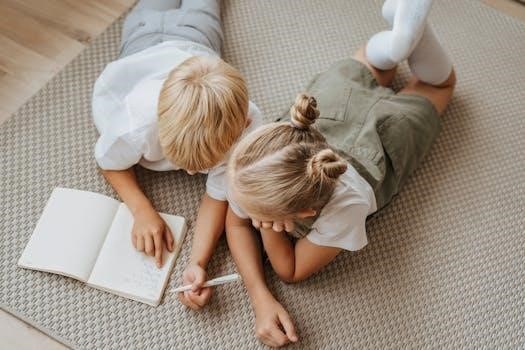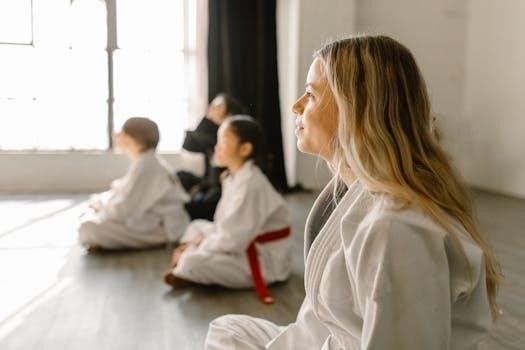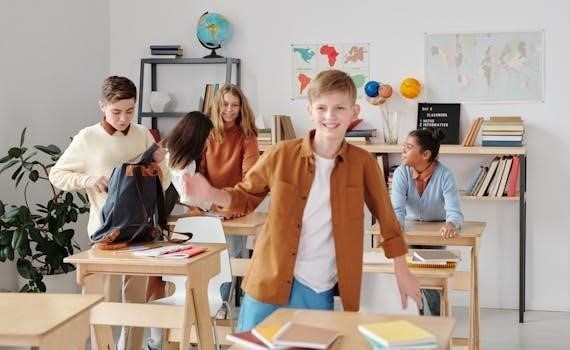
Mindfulness introduces students to present moment awareness‚ without judgment․ It helps to take a break from overthinking․ Practices develop a compassionate understanding of self and surroundings‚ enhancing well-being․ This approach offers lifelong benefits․
What is Mindfulness?
Mindfulness is the practice of paying attention to the present moment without judgment or the need to alter it․ It involves observing your thoughts‚ feelings‚ and bodily sensations as they arise‚ without getting carried away by them․ This intentional focus on the here and now allows students to develop a deeper awareness of themselves and their experiences․ It’s about being fully engaged with what’s happening right now‚ instead of dwelling on the past or worrying about the future․ Mindfulness encourages a non-reactive approach to inner and outer experiences‚ fostering a sense of calm and clarity․ This practice helps students to understand their emotional landscape better‚ allowing them to respond thoughtfully rather than reacting impulsively․ It is a simple yet powerful tool that can be used anytime‚ anywhere․
Benefits of Mindfulness for Students
Mindfulness offers numerous advantages‚ including reduced stress and anxiety‚ enhanced focus and concentration‚ and improved emotional regulation․ It also fosters self-awareness and compassion‚ promoting overall well-being․
Reduced Stress and Anxiety
Mindfulness practices provide students with valuable tools to manage stress and anxiety․ By focusing on the present moment‚ students can detach from worries about the past or future‚ decreasing anxious thoughts․ Regular mindfulness exercises help calm the nervous system‚ promoting relaxation and a sense of inner peace․ These techniques empower students to respond to stressful situations with greater clarity and composure‚ rather than reacting impulsively․ The simple act of observing feelings‚ without judgment‚ allows students to accept their experiences and reduce reactivity to their emotions․ This‚ in turn‚ contributes to lower levels of stress‚ improved emotional wellbeing and a greater sense of calm․
Improved Focus and Concentration
Mindfulness training significantly enhances students’ ability to focus and concentrate․ Through regular practice‚ students learn to direct their attention intentionally‚ reducing distractions and improving their cognitive skills․ The exercises help students develop a greater awareness of their thoughts‚ allowing them to gently redirect their minds when they wander‚ which leads to enhanced focus․ These skills have a direct positive impact on their academic performance‚ enabling students to engage more deeply with their studies and absorb information more effectively․ Improved concentration also helps students stay present and attentive in class‚ further supporting their learning and overall success․ This ability to maintain focus is a valuable asset that can be applied in any area of life․
Enhanced Emotional Regulation
Mindfulness practices greatly assist students in developing better emotional regulation․ By paying attention to their feelings without judgment‚ they learn to recognize and understand their emotions more effectively․ This heightened awareness allows them to respond thoughtfully rather than react impulsively to challenging situations․ Mindfulness helps students create space between their emotions and their actions‚ allowing for a more balanced and considered response․ This ability to manage emotions contributes to improved mental and emotional health‚ fostering a sense of calm and well-being․ Through this training‚ students become more resilient and capable of navigating difficult feelings and situations․ This skill is useful in school and beyond․

Types of Mindfulness Activities
Mindfulness activities for students include breathing exercises‚ mindful eating‚ and sensory awareness․ These fun‚ practical exercises help students connect with the present moment․ Activities can be done anywhere․
Breathing Exercises for Students
Breathing exercises are a simple yet powerful way for students to practice mindfulness․ Techniques like “Balloon Breathing‚” where students imagine their bellies as balloons filling with air‚ can be very effective․ These exercises help students to reset and refocus‚ providing a moment of calm during a busy day․ Deep breathing helps to regulate emotions and reduce feelings of stress and anxiety․ These practices can be done individually or as a group in the classroom․ It is a great way to start or end lessons․ They are easily integrated into a daily routine‚ promoting a sense of well-being and focus․ These exercises are an easy first step into mindfulness․
Mindful Eating Activities
Mindful eating activities encourage students to pay close attention to their sensory experiences while eating․ This practice involves focusing on taste‚ smell‚ texture‚ and even the visual appeal of food․ For example‚ a simple exercise is having students eat a piece of fruit while noting all the details they observe․ This helps them become aware of the present moment and encourages sensory awareness․ The goal is to bring attention to the act of eating itself‚ fostering a deeper connection with the experience․ By slowing down and focusing on each bite‚ students can learn to appreciate their food more and increase their awareness․
Sensory Awareness Exercises
Sensory awareness exercises are designed to help students engage with their surroundings through their senses․ These exercises encourage students to notice what they see‚ hear‚ smell‚ taste‚ and touch in their immediate environment․ This practice can involve activities such as focusing on the sounds around them‚ feeling the texture of different objects‚ or noticing the different colors and shapes in a room․ By paying close attention to sensory details‚ students can enhance their ability to be present in the moment․ These exercises also promote a sense of groundedness and can improve their overall awareness and focus․

Mindfulness Worksheets for Students
Mindfulness worksheets offer practical exercises for students to practice awareness․ These tools include activities that guide students toward self-understanding and cultivate present moment focus‚ aiding in emotional regulation․
Printable Mindfulness Worksheets
Printable mindfulness worksheets provide a convenient way for students to engage with mindfulness practices․ These resources often feature a variety of exercises‚ including coloring pages‚ emotion tracking tools‚ and sensory exploration activities․ Worksheets can be easily integrated into classroom settings or used at home‚ offering flexibility in application․ They help students develop self-awareness‚ manage emotions‚ and enhance focus through engaging‚ accessible content․ These printables can be easily adapted for different age groups and needs‚ making them a versatile tool for educators and parents․ Many include simple exercises that can be done independently‚ promoting self-regulation and reflection․
Guided Meditation Exercises in Worksheets
Guided meditation exercises within worksheets provide structured support for students exploring mindfulness․ These exercises often include step-by-step instructions and prompts that lead students through various meditation techniques․ The worksheets might feature scripts for body scans‚ breathing exercises‚ or visualization practices‚ promoting a sense of calm and focus․ These tools are helpful for both novice and experienced students‚ offering a gentle introduction to meditation․ They allow for self-paced practice‚ fostering relaxation and emotional regulation skills․ Worksheets with guided meditations save time and provide a concrete resource for busy students․
Reflection Prompts in Worksheets
Reflection prompts in mindfulness worksheets encourage students to explore their inner experiences․ These prompts guide students to consider their emotions‚ thoughts‚ and sensations․ Worksheets often include questions that help students analyze their observations during mindfulness exercises․ Students might be asked to explore how their feelings relate to their behaviors and how they can make conscious decisions․ Such prompts develop self-awareness and emotional intelligence․ Through thoughtful reflection‚ students gain a deeper understanding of themselves and the present moment․ These tools create a space for personal growth and enhanced mindfulness․ Reflection aids in understanding the significance of observations and their impact․

Specific Mindfulness Techniques
Specific techniques include body scan meditation‚ and mindful coloring․ Body scans enhance body awareness․ Mindful coloring offers a creative‚ relaxing focus․ These techniques are accessible‚ practical tools for mindfulness․
Body Scan Meditation
Body scan meditation involves bringing awareness to different parts of the body‚ noticing sensations without judgment․ This practice helps students connect with their physical selves and become more attuned to their bodies’ signals․ It can be done by guiding students to slowly focus on each body part‚ starting from the toes and moving up to the head․ It’s a great way for students to anchor themselves in the present moment‚ promoting relaxation․ It is also a useful tool for understanding body sensations․ This technique allows students to be aware of stress or tension․ The goal is not to change anything‚ but simply to observe․ Regular practice can lead to a greater sense of calm and well-being․
Mindful Coloring
Mindful coloring is a simple yet effective mindfulness tool for students of all ages․ This activity involves focusing on the act of coloring‚ paying attention to the colors‚ and the way the crayon moves on paper․ It offers a relaxing break from structured activities․ The process of coloring can help students to quiet their minds‚ giving them a chance to be in the present moment․ Unlike some other mindfulness exercises‚ coloring doesn’t require silence‚ which can make it more accessible for some students․ This practice promotes focus‚ reduces stress‚ and enhances concentration․ It can be a great way to promote creativity and self-expression․ Regular mindful coloring can help students to develop a sense of inner calm․

Implementing Mindfulness in the Classroom
Integrating mindfulness into the classroom can be achieved by incorporating daily routines; Activities like breathing exercises can start or end lessons․ This creates a calm‚ focused learning environment for students․
Integrating Mindfulness into Daily Routine
Incorporating mindfulness into the daily classroom routine can be seamless and beneficial․ Begin by establishing short‚ consistent mindfulness practices‚ such as a brief breathing exercise at the start of the school day‚ or a quick sensory awareness activity before transitioning between subjects․ These moments of calm can help students reset and refocus‚ enhancing their overall learning experience․ These techniques can be integrated into existing classroom schedules without major disruptions․ Teachers can guide students through simple mindfulness exercises‚ fostering a sense of inner peace‚ improved self-regulation and focus throughout the day․ Encourage students to practice these skills outside of the classroom as well for consistent benefits․
Using Mindfulness to Start or End Lessons
Mindfulness exercises can be powerful tools to frame lessons‚ providing students with a sense of calm and focus․ Starting lessons with a brief mindfulness activity‚ like a guided breathing practice or a body scan‚ helps students transition from previous activities and center their attention․ This can be especially helpful in creating a positive learning environment․ Ending lessons with a reflective mindfulness exercise‚ such as mindful coloring or a gratitude practice‚ allows students to process what they’ve learned and helps them to leave the classroom with a sense of peace and accomplishment․ These practices enhance both learning and well-being․